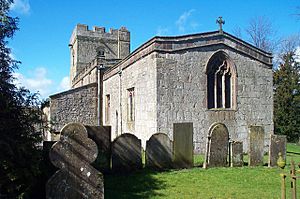All Saints' Church, Bradbourne facts for kids
Quick facts for kids All Saints' Church, Bradbourne |
|
|---|---|

All Saints' Church, Bradbourne
|
|
| 53°04′16.08″N 1°41′27.65″W / 53.0711333°N 1.6910139°W | |
| OS grid reference | SK 20807 52756 |
| Location | Bradbourne, Derbyshire |
| Country | England |
| Denomination | Church of England |
| History | |
| Dedication | All Saints |
| Architecture | |
| Heritage designation | Grade I listed |
| Administration | |
| Parish | Bradborne |
| Deanery | Wirksworth |
| Archdeaconry | Chesterfield |
| Episcopal area | Derby |
| Diocese | Derby |
| Province | Canterbury |
All Saints' Church, Bradbourne is a very old and important church located in the village of Bradbourne, Derbyshire, in England. It's part of the Church of England and is considered a special historical building, known as a Grade I listed building. This means it's one of the most important historic buildings in the country.
Contents
History of the Church
All Saints' Church became the main village church after a big change in England called the dissolution of the monasteries. Before that, it was known as Bradbourne Priory, which was a type of monastery.
Around 1627, the church needed a lot of repairs. Its roof, wooden parts, windows, and bells were all falling apart. Fixing everything was going to be quite expensive for the time.
In 1629, the church leaders of Bradbourne went to court. They said that people from a nearby village called Atlow had always helped pay for repairs to Bradbourne church. However, the people of Atlow had stopped paying. The court decided that the people of Atlow should pay a small amount each year for future repairs.
Church Renovations
The church has been repaired and updated several times over the years.
- In 1876–77, a big restoration took place. The north wall of the main part of the church (the nave) was fixed. A new room for the organ was added. The area around the altar (the chancel) was refitted with new furniture and a stone screen decorated with special tiles showing Bible scenes. The floor was also relaid with beautiful tiles.
- Another major restoration happened between 1906 and 1909. Parts of the church, including the south aisle and the tower, were strengthened. A new oak roof was put on the south aisle, covered with lead. The porch also got a new roof. A new pulpit was added, and the area around the altar was paved with special stone and marble from a local quarry. This work cost a lot of money, but it helped keep the church strong and beautiful.
Famous Burial
The famous film actor Alan Bates, who passed away in 2003, is buried in the churchyard of All Saints' Church.
Church Community
All Saints' Church is part of a group of churches that work together in the local area. This group includes:
- All Saints' Church, Alderwasley
- St James the Apostle's Church, Bonsall
- All Saints' Church, Ballidon
- St James' Church, Brassington
- St Margaret's Church, Carsington
- All Saints' Church, Elton
- St James' Church, Idridgehay
- Holy Trinity Church, Kirk Ireton
- Holy Trinity Church, Middleton-by-Wirksworth
- St Mary's Church, Wirksworth
The Church Organ
The church has a special musical instrument called an organ.
- The first organ was put in the church in 1866 by a company called Rushworth of Liverpool. It had five different sounds (called stops) and a pedal board for playing notes with your feet.
- In 1877, this organ was moved into the new organ room that was built during the renovations.
- Later, in 1893, a new organ was installed by Albert Keates of Sheffield. You can find more details about this organ on the National Pipe Organ Register website.
Church Bells
The church tower holds a set of six bells that can be rung together.
- The two smallest bells were made in 1896.
- The third and fourth bells were made in 1863. All four of these bells were made by John Taylor of Loughborough.
- The two largest bells, the fifth and the tenor bell, are much older, dating back to 1708. They were made by a bell founder named Danuel Hedderly.
See also
- Grade I listed churches in Derbyshire
- Listed buildings in Bradbourne

